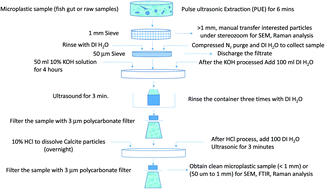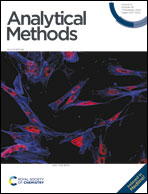A new method for microplastic extraction from fish guts assisted by chemical dissolution
Abstract
A new protocol for the extraction of microplastic is proposed and demonstrated which combines dissection, ultrasonication, and filtration with chemical dissolution in order to estimate microplastic contamination in fish or other samples with significant biomass. This protocol enables initial characterization of the sample through dissection followed by chemical dissolution to isolate polymer debris while minimizing analytical uncertainties and maintaining microplastic particle integrity. The extraction method begins with dissection and inspection of the stomach contents, followed by pulsed ultrasonic extraction to remove the majority of biomass and surface contaminants. Subsequent chemical dissolution of the extracted contents using KOH and HCl removes any remaining biomass and inorganic interferences. Incorporating chemical dissolution post-extraction minimizes the overall biomass subjected to dissolution, thereby enabling faster processing and subsequently a cleaner sample compared to methods involving digestion of the entire organism. Furthermore, the chemical dissolution step enables direct filter analysis for microplastics, thereby minimizing the potential loss of microplastic particles associated with manual particle transfer. Hence, the microplastic extraction method presented here is suitable for the extraction and identification of small (>20 μm) and potentially brittle microplastic.



 Please wait while we load your content...
Please wait while we load your content...